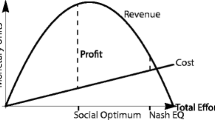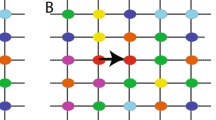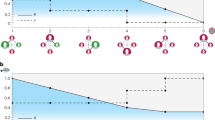Abstract
This paper investigates the role played by cooperation for the sustainable harvesting of an ecosystem. To achieve this, a bio-economic model based on a multi-species dynamics with interspecific relationships and multi-agent catches is considered. A comparison between the non-cooperative and cooperative optimal strategies is carried out. Revisiting the Tragedy of Open Access and over-exploitation issues, it is first proved analytically how harvesting pressure is larger in the non-cooperative case for every species. Then it is examined to what extent gains from cooperation can also be derived for the state of the ecosystem. It turns out that cooperation clearly promotes the conservation of every species when the number of agents is high. When the number of agents remains limited, results are more complicated, especially if a species-by-species viewpoint is adopted. However, we identify two metrics involving the state of every species and accounting for their ecological interactions which exhibit gains from cooperation at the ecosystem scale in the general case. Numerical examples illustrate the mathematical findings.




Similar content being viewed by others
Notes
The Gomperz dynamics (1) is analogous to that used by [15] in the two-dimensional case as the equality \(x^s=e^{s\log (x)}\) entails that
$$\begin{aligned} x_{j}(t+1)=R_{j} x_{j}(t)^{\alpha _{jj}}\prod _{k\ne j} x_{k}(t)^{\alpha _{jk}},\end{aligned}$$with \(R_j=e^{r_j}\), \(\alpha _{jj}=1+s_{jj}\) and \(\alpha _{jk}=s_{jk}\). Interestingly, such a dynamics can also be related to the usual Gomperz monospecific dynamics in continuous time [30]
$$\begin{aligned} {\dot{x}}(t)=rx(t)\log \left( \frac{K}{x(t)}\right) \end{aligned}$$and its ‘Lotka–Volterra’ version
$$\begin{aligned} \dot{x_j}(t)=x_j(t)\left( r_j+ \sum _{k}s_{jk}\log (x_k(t))\right) . \end{aligned}$$Using the first-order approximation of \(x(t+1)\) with respect to x(t) or assuming that the rate of growth \(r_j+ \sum _{k}s_{jk}\log (x_k(t))\) remains constant between period t and \(t+1\), we precisely obtain dynamics (1).
The limit \(\lim _{h_i\rightarrow 0}U(h)=-\infty \) of the logarithmic utility when catch of one species vanishes captures a strong incentive both to the diversity in harvesting and to avoid extinction of every species which is interesting in terms of biodiversity conservation. Of interest is also the fact that this utility function is a case of iso-elastic functions where relative risk aversion is constant. Said differently, the marginal utility of the species \(\frac{\partial U}{h_j}=\frac{a_j}{h_j}\) goes to infinity when this species goes to extinction. At the opposite end, the marginal utility of the species goes to zero when its catch is very large.
This is not a too demanding requirement. Typically, when \(\rho \approx 1\), it means that S is invertible which is the case for most trophic networks. For instance, in the two-species case, we have \(S=\begin{pmatrix}-&{}+\\ -&{}- \end{pmatrix} \) and thus \(\det (S)>0\).
The intuition for the value function to have a log-linear form, namely to be a linear combination of the logarithm of the states \(\log (x)\) arises, first, from the form of the utility function \(U(x)=a'log(x)\), which is also linear in \(\log (x)\), and, second, from the linearity of the dynamics with respect to the (transformed) state \(\log (x(t))\). However, the dynamics is not linear in control, namely catch H or harvest rate F, which makes it possible to use usual first-order optimality conditions in the dynamic programming equation.
This results from the computation of the ratio
$$\begin{aligned} \frac{F_{j}^\mathrm{nc}(n+1)}{F_{j}^\mathrm{nc}(n)}=\frac{a_{j}+\frac{\rho }{n}\left( Mw\right) _{j}}{a_{j}+\frac{\rho }{n+1}\left( Mw\right) _{j}}>1 \end{aligned}$$since \((Mw)_{j}>0\) for every species j and \(\rho >0\).
The characteristic function is defined by
$$\begin{aligned}\mathbbm {1}_{\mathbb {R}_+^*}(x)=\left\{ \begin{array}{ll} 1 &{} \quad \hbox {if}\; x>0\\ 0&{}\quad \hbox {otherwise} \end{array}\right. \end{aligned}$$From the very definition of \(w\) (Eq. 9), we derive that \((I-\rho M)w=a\) or equivalently
$$\begin{aligned} w- a=\rho Mw\end{aligned}$$As \(Mw>0\) then we deduce \(w-a>0\) as expected.
Simulations have been done using the scientific software Scilab 5.5. The numerical codes are displayed in “Appendix.”
Regarding uniqueness, we have not find out clear proof in the literature. However, as mentioned in [15], in view of the log-linear nature of the objective and dynamics, it seems unlikely that another functional form can serve as a value function. This belief is also derived from the functional form of the value function for finite horizon versions of this problem. Finally, our belief in the uniqueness of the solution is bolstered by the fact that given this log-linear form, there is a unique solution satisfying the functional equations.
The computation of the term \(\upsilon ^\mathrm{nc}\) is omitted.
References
Bailey M, Sumaila U, Lindroos M (2010) Application of game theory to fisheries over three decades. Fish Res 102:1–8
Basar T, Older GJ (1995) Dynamic non cooperative game theory, 2nd edn. Academic Press, London
Breton M, Keoula M (2011) Farsightedness in a coalitional great fish war. Environ Resour Econ 51(2):297–315
Breton M, Keoula M (2014) A great fish war model with asymmetric players. Ecol Econ 97:209–223
Brock WA, Xepapadeas A (2003) Valuing Biodiversity from an economic perspective: a unified economic, ecological, and genetic approach. Am Econ Rev 93(5):1597–1614
Cissé A, Gourguet S, Doyen L, Blanchard F, Pereau J-C (2013) A bio-economic model for the ecosystem-based management of the coastal fishery in French Guiana. Environ Dev Econ 18:245–269
Crooks KR, Soulé ME (1999) Mesopredator release and avifaunal extinctions in a fragmented system. Nature 400:563–566
Datta L, Mirman L (1999) Externalities, market power and resource extraction. J Environ Econ Manag 37:233–255
DeLara M, Doyen L (2008) Sustainable management of natural resources: mathematical models and methods. Springer, Berlin
Doyen L, Cissé A, Gourguet S, Mouysset L, Hardy P-Y, Béné C, Blanchard F, Jiguet F, Pereau J-C, Thébaud O (2013) Ecological-economic modeling for the sustainable management of biodiversity. Comput Manag Sci 10:353–364
Doyen L, Pereau J-C (2012) Sustainable coalitions in the commons. Math Soc Sci 63(1):57–64
Dutta PK, Sundaram P (1992) Markovian equilibrium in a class od stochastic game. Existence theorems for discounted ans undiscounted models. Econ Theory 2:197–214
Dutta PK, Sundaram P (1993) The tragedy of commons. Econ Theory 3:413–426
Finus M (2001) Game theory and international environmental cooperation. Edward Elgar, Cheltenham
Fischer R, Mirman L (1992) Strategic dynamic interaction. J Econ Dyn Control 16:267–287
Fischer R, Mirman L (1996) The compleat fish wars: biological and dynamic interactions. J Environ Econ Manag 30:34–42
Hannesson R (1997) Fishing as a Supergame. J Environ Econ Manag 32:309–322
Hardy PY, Doyen L, Béné C, Schwartz AM (2013) Food security-environment conservation nexus: a case study of Solomon Islands’ small-scale fisheries. Environ Dev. http://www.sciencedirect.com/science/article/pii/S2211464513000584
Kaitala V, Munro GR (1995) The economic management of high seas fishery resources: some game theory aspects. In: Carraro C, Filar JA (eds) Annals of the international society of dynamics games: control and game-theoretic models of the environment, Birkhauser. Birkhauser, Boston, pp 299–318
Kaitala V, Lindroos M (2007) Game theoretic applications to fisheries. In: Weintraub A et al (eds) Handbook of operations research in natural resources, vol 99. Springer, Berlin, pp 201–215
Kellner J, Sanchirico J, Hastings A, Mumby P (2011) Optimizing for multiple species and multiple values: tradeoffs inherent in ecosystem-based fisheries management. Conserv Lett 4(1):21–30
Kwon OS (2006) Partial international coordination in the great fish war. Environ Resour Econ 33:463–483
Larkin SL, Alvarez S, Sylvia G, Harte M (2011) Practical considerations in using bioeconomic modeling for rebuilding fisheries. OECD food, agriculture and fisheries working papers
Levhari D, Mirman L (1980) The great fish war: an example using a dynamic Cournot-Nash solution. Bell J Econ 11:322–344
Long NV (2010) A survey of dynamic games in economics. World Scientific Publishing, Singapore
Magurran AE (1988) Ecological diversity and its measurement. Croom Helm Limited, London
Mesterton-Gibbons M (1993) Game-theoretic resource modeling. Nat Resour Model 7:93–146
Mesterton-Gibbons M (1996) A technique for finding optimal two-species harvesting policies. Ecol Model 92:235–244
Mutshinda C, O’Hara E, Woiwod I (2009) What drives community dynamics? Proc B R Soc 276:2923–2929
Nobile AG, Ricciardi LM, Sacerdote L (1982) On Gompertz growth model and related difference equations. Biol Cyb 42:221–229
Ostrom E (1990) Governing the commons. Cambridge University Press, Cambridge
Pereau J-C, Doyen L, Little R, Thébaud O (2012) The triple bottom line: meeting ecological, economic and social goals with individual transferable quotas. J Environ Econ Manag 63:419–434
Pauly D, Watson R (2005) Background and interpretation of the ’Marine Trophic Index’ as a measure of biodiversity. Philos Trans R Soc B Biol Sci 360:415–423
Pikitch EK, Santora C, Babcock EA, Bakun A, Bon R, Conover DO, Dayton P, Doukakis P, Fluharty D, Heneman B, Houde ED, Link J, Livingston PA, Mangel M, McAllister MK, Pope J, Sainsbury KJ (2004) Ecosystem-based fishery management. Science 305:346–347
Plagányi E et al (2014) Multispecies fisheries management and conservation: tactical applications using models of intermediate complexity. Fish Fish 15(1):1–22
Quaas M, Requate T (2013) Sushi or fish fingers? Seafood diversity, collapsing fish stocks, and multi-species fishery management. Scand J Econ 115(2):381–422
Rose KA et al (2010) End-to-end models for the analysis of marine ecosystems: challenges, issues, and next steps. Mar Coast Fish 2(1):115–130
Sanchirico JN, Smith MD, Lipton DW (2008) An empirical approach to ecosystem-based management. Ecol Econ 64:586–596
Wiszniewska-Matyszkiel A (2002) Discrete time dynamic games with continuum of players I: decomposable games. Int Game Theory Rev 4:331–342
Acknowledgments
This work has been carried out with the financial support of the Belmont Forum through the SEAVIEW network. IHP (Institut Henri Poincaré) played also a major role during the three-month international program ‘Mathematics of Bio-Economics’ organized in Paris as part of the event ‘Mathematics of Planet Earth 2013.’ Support from the PIG CNRS under the ECOPE, VOGUE and GECO research projects has also been important.
Author information
Authors and Affiliations
Corresponding author
Appendices
Appendix 1: Proofs
1.1 Proof of Proposition 1
The resolution of the model follows the method proposed by [25] (see Section 3.1.3 ‘Some technical notes on feedback strategies in fishery problems,’ pp. 82–84).
First set the vector \(y(t)=\log (x(t)')=(\log (x_{1}),\ldots ,\log (x_{m}))^{\prime }\). Taking the logarithm of ecosystem dynamics (2) controlled by the harvesting rate \(F=(F_{1},\ldots ,F_{m})^{\prime }\) gives the linear dynamics written in matrix form
where we use the notation \(M=( I+S)'\) as defined in Eq. (8). Using the change of variable from x(t) to \(y(t)\), Bellman equation corresponding to the non-cooperative optimization problem (5) can be written as follows
where \(F_{-i}\) stands for the aggregate catch rate of players different than i. Using the dynamics (27), it reads
Following [25] or [15], we now prove that the value function (assumed to be uniqueFootnote 9) takes a log-linear form; namely, it is a linear combination of logarithms y in the sense that
where \(\upsilon \) and \(w\) are vectors of size \((m\times 1)\). We determine the coefficients \(\upsilon \) and \(w\) by applying the Bellman principle. The Bellman equation for every agents i becomes
First-order optimality conditions give for every species j
We deduce that users are identical in the sense that \(F_{ij}=F_{j}\) for every i. Thus, \(F_{(-i)j}=(n-1)F_{ij}\) and we obtain
The aggregate non-cooperative harvesting rate is
as required. The scarcity constraint \(F_{j}^\mathrm{nc}\le 1\) is satisfied because of assumption \(\rho \left( Mw\right) _{j}>0\).
The vector \(w\) is obtained by identification with the form of the value function \(V(y)=\upsilon +w^{\prime }y\). We obtainFootnote 10
or equivalently \(w=\left( I-\rho M\right) ^{-1}a\) as required.
1.2 Proof of Proposition 5
In the cooperative case, we know from Proposition 2 that
Consequently from assumption \(Mw> 0\), we derive that
Assume now for a moment that \(\displaystyle \lim _{n\rightarrow +\infty } x_{j}^\mathrm{c} (1)=0\). From Gompertz dynamics (1), this implies that
This is contradictory since the initial state \(x_j^\mathrm{c}(0)\) is supposed to be strictly positive in all of its components and the exponential is also strictly positive.
We proceed iteratively to obtain the assertion for every time \(t=2, \ldots \).
1.3 Proof of Proposition 7
By taking the logarithm of the exploited dynamics (2) at the steady state \(x_j(t+1)=x_j(t)={x_{*}}_j\), we obtain
Since \(h_{j}=F_{j}x_{j}\) it yields
In matrix form, it gives
where the notation \(\log \left( x\right) \) means the vector of logarithms by species, namely \((\log \left( x\right) )_j=\log \left( x_j\right) \). Assuming that S is invertible, this reads:
with \(L=r+M' \log \left( 1-F\right) \). The comparison between species states in the cooperative \(x_{*}^\mathrm{c}\) and non-cooperative \(x_{*}^\mathrm{nc}\) cases yields
We deduce that
Since for every species \(\dfrac{1-F^\mathrm{c}}{1-F^\mathrm{nc}}\ge 1\), we conclude with
1.4 Proof of Proposition 8
Consider the optimal cooperative \(x^\mathrm{c}(t)\) and non-cooperative \(x^\mathrm{nc}(t)\) trajectories starting from the same initial state \(x_0\). Let us prove that
Taking the logarithm formulation of Eq. (2), we can derive by iteration that
We deduce that
since the cooperative and non-cooperative initial states \(y_0^\mathrm{nc}=y_0^\mathrm{c}\) coincide. Using matrix properties, the difference reads as follows:
The assumption of Proposition 8 guarantees that vector \(M^sw\) is positive for every species j and every time s. Moreover, from Proposition 3 related to the gain from cooperation for catch rates, the difference \(\log (1-F^\mathrm{nc})-\log (1-F^\mathrm{c})\) is always non-positive for every species j.
Appendix 2: Scilab Code for the Simulations
Below is the Scilab code used for the simulations. Scilab is an open-source software for numerical computation available at http://www.scilab.org/en/download/latest

Rights and permissions
About this article
Cite this article
Doyen, L., Cissé, A.A., Sanz, N. et al. The Tragedy of Open Ecosystems. Dyn Games Appl 8, 117–140 (2018). https://doi.org/10.1007/s13235-016-0205-3
Published:
Issue Date:
DOI: https://doi.org/10.1007/s13235-016-0205-3
Keywords
- Fish war
- Ecosystem
- Biodiversity
- Bellman optimization
- Markov-perfect Nash equilibrium
- Intermediate complexity




